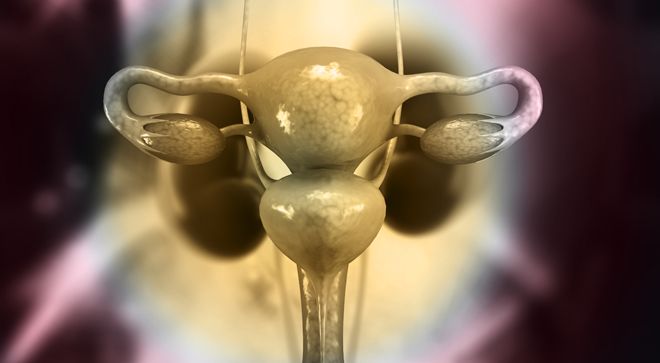Keytruda (pembrolizumab) plus chemoradiotherapy, followed by Keytruda monotherapy, significantly improved survival versus chemoradiotherapy alone in newly diagnosed, previously untreated, high-risk locally advanced cervical cancer, according to updated data from the phase 3 ENGOT-cx11/GOG-3047/KEYNOTE-A18 study presented during a press briefing of the 2024 ESMO Congress.
The data, which were simultaneously published in The Lancet, showed that at a median follow-up of 29.9 months, the 36-month overall survival (OS; the time when a patient with cancer is still alive) rate was 82.6% with Keytruda plus chemoradiotherapy versus 74.8% with chemoradiotherapy alone. The median OS was not reached (NR) in either arm, meaning that at least half of patients in the study are still alive at the time the data were analyzed.
Study Highlights:
- Keytruda plus chemoradiotherapy significantly improved overall survival compared to chemoradiotherapy alone in patients with high-risk locally advanced cervical cancer.
- The risk of death was reduced by 33% in patients receiving Keytruda plus chemoradiotherapy.
- Keytruda plus chemoradiotherapy had a manageable safety profile, with no new safety signals observed.
- Patients treated with Keytruda plus chemoradiotherapy had a significantly longer time before disease progression compared to those receiving chemoradiotherapy alone.
- The benefits of Keytruda plus chemoradiotherapy were observed across various patient subgroups, including those with different stages of disease and PD-L1 expression levels.
“When we add [Keytruda], the risk of death is reduced by 33%, and it is really remarkable for this tumor, which is among the worst among the gynecological malignancies; it involves younger patients,” Dr. Domenica Lorusso, of the Gynaecology/Oncology Unit of Fondazione Policinico Universitario A. Gemelli IRCCS, Rome and Humanitas San Pio X, in Milan Italy, said in a press briefing at the congress where she initially shared some of the data. “It is a really painful tumor for women. In the locally advanced setting, it is our only opportunity to cure a larger number of patients, and [Keytruda] is able to do it.”
The phase 3 study enrolled patients 18 years of age or older with newly diagnosed, locally advanced squamous cell carcinoma, adenocarcinoma or adenosquamous carcinoma of the cervix. Patients needed to have high-risk disease. Patients were required to have an ECOG performance status of 0 or 1 (fully active or restricted in usual activities), acceptable organ function and available tissue for sampling.
They were randomly assigned to receive [Keytruda] plus chemoradiotherapy followed by [Keytruda] or placebo plus chemoradiotherapy followed by placebo.
The primary endpoints of the trial were progression-free survival (PFS; the time during and after treatment when a patient with cancer is alive without disease worsening) and OS. Secondary endpoints included 24-month PFS, 36-month OS, objective response rate (the percentage of patients with a complete or partial response to treatment), duration of response, patient-reported outcomes and safety.
A total of 1,060 patients were randomly assigned at 176 clinical sites spanning 30 countries. A total of 529 patients were allocated to the Keytruda/chemoradiotherapy arm, and they comprised the intention-to-treat (ITT)/efficacy population; 528 were treated, and they represented the as-treated/safety population. At the time of data cutoff, 16.3% remained on treatment, 41.5% completed treatment and 42.2% discontinued; the main reason for discontinuation in this group was radiographic progression (108 patients).
A total of 531 patients were allocated to the placebo/chemoradiotherapy arm, and they comprised the ITT/efficacy population; 530 were treated and they represented the as-treated/safety population. At cutoff, 16% remained on treatment, 39.4% completed treatment and 44.5% discontinued; radiographic progression was also the most common reason for discontinuation in this group (158 patients).
“More than 95% of patients had PD-L1–positive tumors [defined as having a] combined positive score of 1 [or higher],” Lorusso said. “Fifty-six percent of patients had stage 3 and 4A [disease], 85% had positive lymph nodes, and in particular, 62% in the pelvis and [about] 20% in the pelvic and para-aortic area.”
With regard to treatment exposure, the median number of Keytruda or placebo cycles in the respective arms was 17 and 16. The median number of cisplatin cycles in both arms was 5. Overall treatment time for radiotherapy in the Keytruda and placebo arms was 52 days. In the Keytruda arm, radiotherapy was completed within 50 days for 35.5% of patients and within 56 days for 74.2% of patients. “This is remarkable considering it is a global trial in 146 patients during the [COVID-19] pandemic,” Lorusso noted. In the placebo arm, these respective rates were 36.8% and 74.7%. The median duration of external beam radiation therapy and brachytherapy was 37 days and 12 days, respectively, in both arms.
PFS data were shared at the time of the first analysis, which had a median follow-up of 17.9 months. The 24-month PFS rate with Keytruda plus chemoradiotherapy was 67.8% versus 57.3% with chemoradiotherapy alone. The median PFS was NR in both arms, meaning that at least half of patients had not experienced disease progression or death at the time data were analyzed; the 30% reduction in the risk of disease progression was determined to be of statistical significance.
“Considering that the PFS endpoint [met] successful criteria at the first interim analysis, we did not [formally] analyze at the second interim analysis,” she added. With a median follow-up of 29.9 months, the 36-month PFS rate in the [Keytruda] arm was 69.3% versus 56.9% in the placebo arm. The median PFS was still NR in both arms.
Keytruda plus chemoradiotherapy had a manageable safety profile. “We were surprised of the good tolerability of [Keytruda] in combination with chemoradiation,” she said. “There were no new safety signals.” With longer follow-up, 78.2% of those in the Keytruda arm and 70% of those in the placebo arm experienced grade 3 (severe) or higher all-cause side effects; grade 3 or higher treatment-related side effects occurred in 69.1% and 61.3% of patients, respectively. All-cause serious side effects were experienced by 32.6% of those in the Keytruda arm versus 28.5% of those in the placebo arm; they were treatment related in 19.3% and 13.4% of patients, respectively. Any treatment discontinuation due to side effects was reported in 20.6% and 14.9% of patients in the respective arms. “Of note, only one patient in the [Keytruda] arm discontinued all treatment for a non–[Keytruda]-related AE,” Lorusso said.
The most common treatment-related side effects experienced by 20% or more patients in the Keytruda and placebo arms, respectively, were anemia (60.0% versus 55.8%), nausea (57.6% versus 59.8%), diarrhea (50.8% versus 51.1%), decreased white blood count (32.8% versus 34.5%), decreased neutrophil count (low level of a type of white blood cell that helps the body against infections; 29.5% versus 27.9%), vomiting (25.6% versus 28.3%), leukopenia (decreased number of a type of white blood cell that helps the body against infections; 23.7% versus 17.4%), decreased platelet count (blood cells that help your blood to clot, and low levels may lead to your body taking longer to stop bleeding; 22% versus 20.6%), neutropenia (low levels of neutrophils in the body; 21.6% versus 17.7%) and hypothyroidism (when the thyroid gland does not produce enough thyroid hormone; 21.2% versus 5.7%).
“We pay particular attention to diarrhea because of a possible overlapping toxicity between autoimmune-related colitis and post-radiotherapy colitis. However, no signals [were observed],” Lorusso noted.
The most common immune-mediated side effects experienced by three or more patients in the Keytruda or placebo arms were hypothyroidism (22.5% versus 6.8%), hyperthyroidism (when they thyroid gland produces too much thyroid hormone) 12.1% versus 2.8%), gastritis (inflammation of the lining of the stomach; 4.2% versus 3.8%), colitis (inflammation of the colon; 3% versus 2.1%), thyroiditis (inflammation of the thyroid gland; 2.3%; 0.4%), pneumonitis (inflammation of the lungs; 1.9% versus 0.9%), severe skin reactions (1.3% versus 0.9%), adrenal insufficiency (when the adrenal glands do not produce enough cortisol, which helps the body respond to stress; 0.8% versus 0%), nephritis (inflammation of the kidneys; 0.6% versus 0.2%), and pancreatitis (inflammation of the pancreas; 0.6% versus 0.2%).
For more news on cancer updates, research and education, don’t forget to subscribe to CURE®’s newsletters here.






